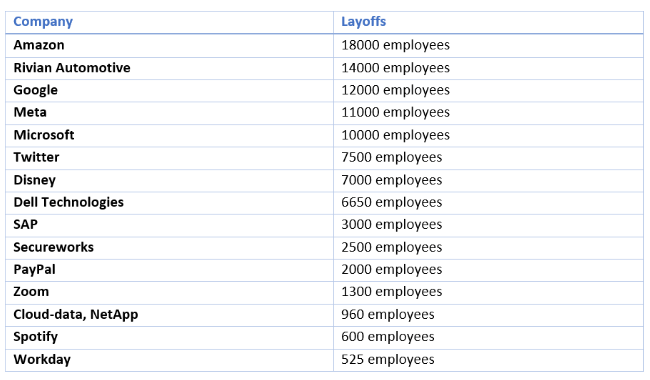The Economist featured this week the illustration by Bernard Hage, a German Artist of Lebanese origin. The illustration sheds light on the impact of the economic downturn on the technology industry and the employees who have been affected by it, such as 2023 layoffs at some of the largest companies.

Layoffs 2023 by Bernard Hage
Layoffs have become a common reality in today’s global economy, especially with the rise of automation and globalization. The pressure of the stock market and concerns about a potential recession add to the uncertainty, as companies try to cut costs and remain profitable in a challenging business environment. This can lead to job loss for many employees and can have a significant impact on their lives and the broader economy. It’s important for both individuals and organizations to be prepared for these changes and to have contingency plans in place.
Thousands of employees have been severely impacted by the widespread job losses, which have caused them to feel insecure financially and experience stress and anxiety. While layoffs may seem like a necessary step in the short term, they come with significant long-term consequences.
By taking a closer look at the costs and benefits of layoffs, this article provides a comprehensive understanding of why companies should consider alternative solutions to layoffs in the future.
Massive Layoffs Aren’t Over
Since the end of last year until today, major technology organizations have announced layoffs.
With Twitter laying off 7500 employees and Google following suit with 12000 employees, the trend is set to continue through 2023. Table 1 highlights the companies that have announced job cuts and the number of employees impacted. This information was gathered from publicly available data sources.

Table 1. 2023 Layoffs. Source: Forbes, LinkedIn News
Employee Layoffs May Create More Problems Than They Solve
Layoffs may result in immediate savings, but they can have catastrophic long-term effects on an organization.
The article by Harvard Business Review collected various studies published by scholars all around the world and concluded that the majority of organizations that decided to conduct layoffs do not see improved profitability, return on assets, return on equity, or return on sales. Layoffs are also negatively influencing performance of companies, which highly rely on R&D.
Good Reasons for Not Laying Off Employees:
- Hiring an Excellent Team Takes a Lot of Effort
Recruiting and retaining talented employees is one of an organization’s most challenging responsibilities.
One of the worst mistakes is letting go of the right people once companies find them. Although downsizing may initially result in some financial savings for large corporations, what if those same enterprises end up losing the skills necessary for long-term success?
The extreme option is to fire employees. But there are always better options to consider. Instead of letting go of a fantastic team, companies could consider cutting back on part-time workers and consultant hours, as well as other expenses such as unused tools, technology, or benefits.
- The Severance Pays and The Costs of New Hires Are High
Severance paying for laid-off employees can also add to the costs for companies. Notice of termination compensation is common in many countries to provide financial support to employees who have lost their job. It is meant to help them transition to a new job and provide some financial stability during the transition period. The length of the notice period and the amount of pay can vary depending on the country, the type of job, and the length of service of the employee. Indeed, some employees may not be as productive during the notice period, especially if they are actively seeking new employment.
When laying off employees, one error that many organizations make is eliminating positions that they cannot afford to lose.
Costs of hiring, recruiting, and training can be significant for companies. Recruiting and hiring new employees require resources such as advertising and job search sites, as well as time spent by HR staff reviewing resumes, interviewing candidates, and conducting background checks. According to the U.S. Department of Labor, the price of a bad hire is at least 30 % of the employee’s first-year earnings. Bringing in new employees requires costs that include both direct costs and costs associated with the time and effort spent during the process.
Check more about recruiting costs here: Why Losing the Best Talent is so Costly.
- It’s Challenging to Find Employees
Today’s companies, especially small and medium-sized ones, have a difficult time finding and retaining talent.
The commitment and productivity of the company’s employees might be disrupted by downsizing, which can have an impact on revenues and bottom-line earnings. Downsizing results in the loss of experienced talent and disrupts the social networks necessary to foster creativity and adaptability within the organizational culture. If management doesn’t respond right away by rethinking tasks and introducing new technologies to make up for the loss of talent, this could have a significant negative impact on the company’s success.
The HR department assumes a key leadership and management role when it comes to avoiding layoffs. The extent of their investments in physical and human capital is being reevaluated by several technological organizations. Companies intend to restructure their workforce, but they are having trouble doing so because of a lack of data and advanced tools.
Avoiding Layoffs During Challenging Times
Layoffs are frequently one of the first fears that come to the thoughts of professionals during challenging economic times. Many companies resorted to employee layoffs during severe economic downturns or impending recessions. Layoffs do not, however, must be the sole option. The strategies organizations can use to prevent firing people during lean times are discussed here, along with reasons why they would be a better long-term option.
- Reduced Hours and Temporary Pay Cuts
Employees could be asked to work fewer hours or accept a temporary wage cut to help the company get through these trying times rather than being let go. The organization must be fair and equal in any reductions that are implemented, as well as clearly and honestly communicate the situation to employees. To aid team members in the transition, it is also beneficial to provide support services like counseling or financial planning tools. This could assist in keeping jobs and boosting morale.
In general, when facing difficult circumstances, it’s critical for companies to be proactive and weigh all their options. According to Gartner, 77% of employees say Senior Executives should be willing to take a significant pay cut before they reduce headcount or make changes to employee compensation.
As an example, Intel made several changes to its 2023 employee compensation and rewards programs as it continues to manage macroeconomic challenges and try to cut expenses throughout the organization. CEO of Intel Pat Gelsinger will receive a 25% cut of a baseline salary, with the rest of the executive team receiving a 15% cut and mid-level managers – a 5% cut. These changes are intended to support workforce expansion and the investments required to speed up the transition while achieving the long-term vision.
- Remote Work
When times are tough, avoiding layoffs is possible by embracing remote working. By eliminating the need for office space and all its associated expenses, including rent, utilities, and equipment, a remote workforce enables organizations to reduce costs. The resulting cost savings could help managing layoffs and keeping employees on board during challenging times. Ultimately, embracing remote working is a great way to increase productivity while reducing costs. A poll by Business Insider shows that 39% of employees would consider quitting their job if not provided the opportunity to work from home.
- Training Programs
Investing in a strong training program is one of the best strategies to keep employees from being let go. Companies can move team members around if they are adaptable and capable of performing different responsibilities when one department or position becomes stagnant. Executives in all industries who want to guarantee optimal productivity and job security must have a team with a variety of skill sets and competencies.
The HR department plays a crucial role in managing and executing layoffs, as they are often responsible for communicating the changes to employees, handling benefits and severance packages, and ensuring compliance with labor laws and regulations. As companies reassess their investments in both physical and human capital, the HR department must navigate these changes with sensitivity and fairness.
The lack of data and advanced tools can make it challenging for companies to restructure their workforce effectively and efficiently. Without access to reliable data, companies may struggle to make informed decisions about which employees to retain, which positions to eliminate, and how to manage the transition process. This can lead to delays and difficulties in implementing the changes, as well as a negative impact on employee morale and company reputation.
Companies need to invest in the tools and resources needed to make informed decisions about their workforce. By leveraging data and technology, HR departments can develop effective workforce management strategies that minimize the negative effects of layoffs and support the long-term success of the company.
EDLIGO Talent Analytics assists organizations in establishing a clear, objective, and data-driven baseline for their employees. The EDLIGO platform helps organizations identify top performers and future leaders, discover great skills within their organization, develop employees for the future, increase retention rates, and maximize employee engagement.

